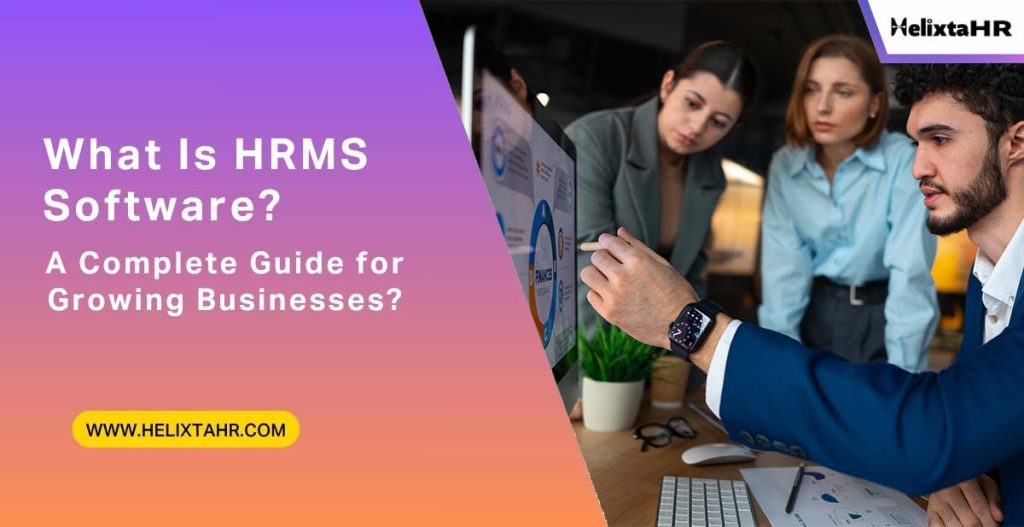HRMS software supports businesses that are growing fast and need better ways to manage people. Instead of using separate tools or spreadsheets, everything stays connected. This system helps track employee records, handle payroll, monitor attendance, and manage tasks in one place.
Companies choose HRMS software for small businesses to reduce workload, avoid confusion, and support a smooth experience for both the HR team and employees. The software is often used for hiring, storing data, running reports, and even keeping track of leaves and benefits. So, what is HRMS software used for in growing businesses? It is used to bring order and structure to how teams work, grow, and improve.
What Is HRMS Software?
HRMS stands for Human Resource Management System. It brings together several human resource tasks into one digital platform. This includes employee data, performance reviews, payroll, onboarding, and more.
Companies often wonder what is HRMS software and how it helps. Think of it as the central brain for managing staff. Instead of switching between tools, everything happens inside one system.
There’s also confusion between HRMS vs HRIS vs HCM software. HRIS (Human Resource Information System) mainly stores employee information. HCM (Human Capital Management) takes a broader view by adding strategic functions like workforce planning. HRMS includes both of these, often with extra tools like payroll and performance tracking.
Key Features of HRMS Software
Payroll Management
Manual payroll takes time and often causes errors. An HRMS software with payroll integration calculates pay, applies tax rules, and sends payslips automatically. That removes guesswork and improves accuracy.
Attendance Tracking
Time logs matter for productivity and compliance. An HRMS time and attendance tracking software lets staff clock in from phones or desktops, while HR teams monitor leave, overtime, and absentee trends.
Performance Reviews
HRMS with performance management features helps managers set goals, give feedback, and track progress. Instead of waiting for yearly reviews, teams can follow performance regularly.
Employee Database
A single record includes personal details, job roles, documents, and history. HR teams no longer dig through files. The software keeps everything safe, accurate, and searchable.
Mobile Access
Access from phones or tablets supports employees working on the go. Many use mobile apps to request time off, check schedules, or review payslips.
Compliance Tools
Rules change fast. HRMS tools help meet legal and policy needs by keeping records updated and alerts active. This reduces risk, especially for growing teams that deal with audits or regulations
Benefits of HRMS for Growing Businesses
Growth brings more people, more tasks, and more complexity. HRMS solves this by reducing time spent on manual work and helping teams move faster.
Time Savings
One platform means less jumping between systems. Tasks like approving leave, running payroll, or checking records take minutes instead of hours.
Reduced Errors
A centralized system lowers mistakes. When data stays updated and linked, things like duplicate entries, missed payments, or outdated files happen less.
Scalability
As a company grows, the system grows too. Whether there are 10 or 200 employees, it keeps working without much extra setup. Many look for the best HRMS software for compliance and scalability to stay ready for future changes.
Better Employee Experience
People appreciate clear communication. With HRMS tools, they check their info, request leave, and stay informed. This improves trust and helps with retention.
The benefits of HRMS software for SMEs become clear as teams expand. It keeps the people side of the business strong and steady, without extra stress.
HRMS Software for Different Business Types
Every business has unique needs, but HRMS adapts to those differences.
Small Businesses
These teams often run lean. HRMS software for small businesses helps handle hiring, leave tracking, and payments without needing a large HR department.
Startups
Startups need fast, flexible tools. A cloud-based HRMS for startups supports remote logins, scalable pricing, and quick setup. It fits the fast-moving nature of early-stage companies.
Remote-First Companies
With teams spread across cities or countries, keeping track of hours and work becomes hard. HRMS software for remote teams solves this by tracking attendance online and syncing updates in real time.
How to Choose the Right HRMS Software
The right HRMS depends on business size, workflow needs, and future goals. Start by asking these questions:
- How many employees need to be managed?
- What problems must be solved first (payroll, tracking, records)?
- What other tools should it connect with (accounting, time tracking)?
- How easy is it to learn and use daily?
- Is there customer support if something goes wrong?
- Does it fit the budget and scale as the team grows?
Simple Checklist:
- Handles payroll automatically
- Tracks time and attendance
- Manages performance reviews
- Allows employees to self-manage info
- Works on mobile devices
- Keeps data secure and compliant
- Offers reporting tools
- Fits within the planned budget
- Grows as the business scales
This list gives a strong starting point when comparing different systems. Always test the software first and review support options.
Is HRMS Worth It for Your Growing Business?
An HRMS helps people work better, not harder. It keeps data organized, tasks simple, and HR stress low. It supports the shift from managing tasks manually to running a well-connected system that serves employees and leadership alike.
For growing businesses, the shift to HRMS pays off in saved time, lower risk, and smoother processes. It also creates a better experience for every employee, which leads to better work and stronger teams.
If the goal is growth without chaos, Helixta HR provides a system that keeps things steady—day after day.
FAQs
What’s the difference between HRMS and HRIS?
HRIS focuses on storing and managing employee data. HRMS includes everything in an HRIS plus tools for payroll, performance, attendance, and more.
What features should I look for in an HRMS?
Look for payroll integration, attendance tracking, performance reviews, employee records, mobile access, and compliance support. These cover most core HR needs.
Why your business needs HRMS software?
It saves time, reduces errors, keeps data organized, and supports smooth team growth—especially useful when manual processes slow down daily work.



